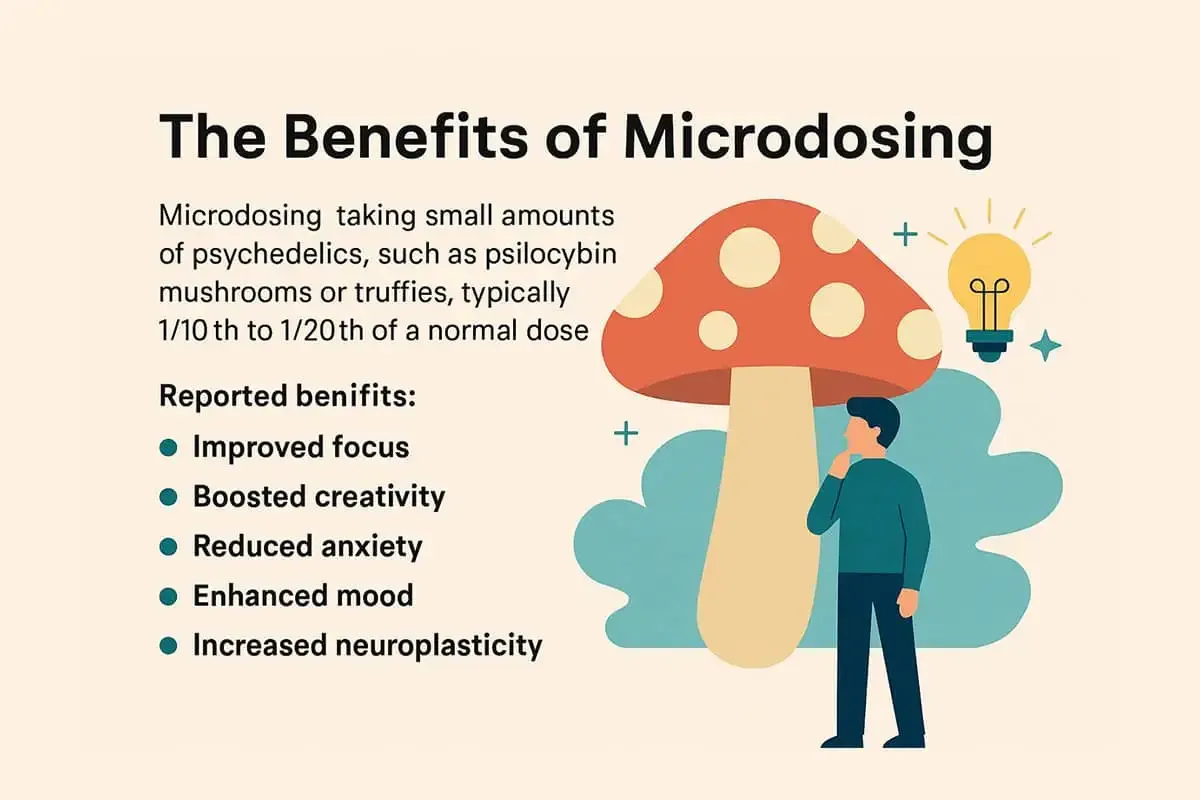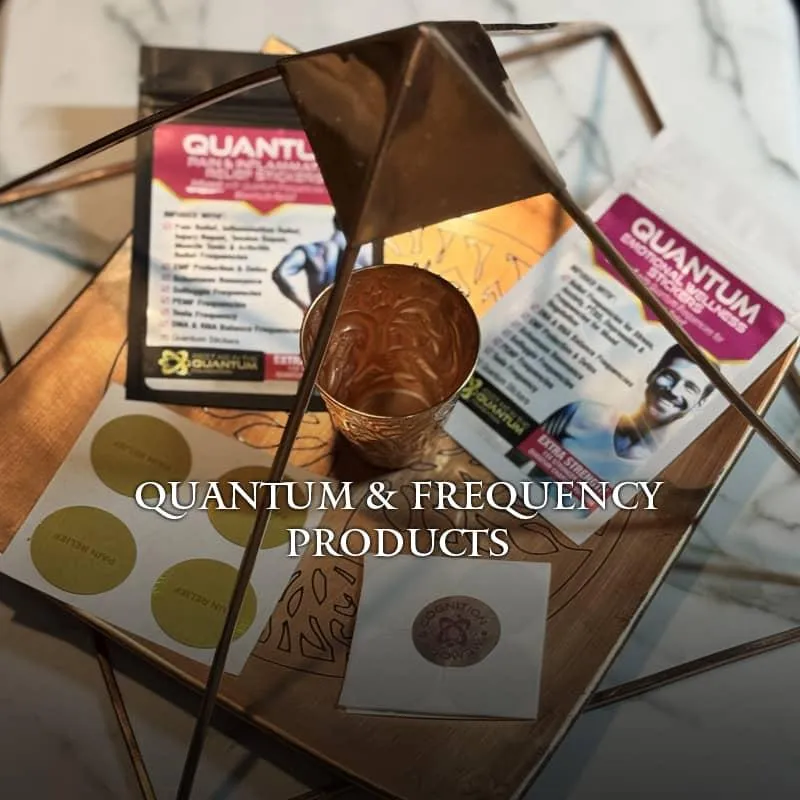
The Benefits of Microdosing: A Gateway to Clarity, Creativity & Personal Growth
Microdosing psychedelics is gaining traction as a safe, natural tool for improving mental well-being and personal development. Whether you're looking to boost creativity, sharpen your focus, or simply reconnect with your inner self, microdosing may offer the key.
“A 2020 Johns Hopkins JAMA Psychiatry study found that two psilocybin sessions with therapy led to remission in over 70% of participants with major depression at 4 weeks (71%), with sustained improvements in 75% of participants at 12 months – and similarly point out the Usona Institute’s Phase 3 trial and Compass Pathways’ COMP360 results."
What Is Microdosing?
Microdosing involves taking small, sub-perceptual amounts of psychedelic substances like psilocybin mushrooms or truffles—usually 1/10 to 1/20 of a standard dose. The goal is not to hallucinate but to elevate your baseline state of awareness, creativity, and mental clarity.
Commonly Reported Benefits:
Improved focus and productivity
Enhanced creativity and problem-solving
Emotional resilience and stress reduction
Greater self-awareness and spiritual insight
Relief from anxiety, depression, and burnout
How Does Microdosing Work?
The effects of microdosing stem from psilocybin’s interaction with the 5-HT2A serotonin receptor, triggering neuroplasticity—the brain’s ability to form new neural connections. This helps rewire old thought patterns and enhance adaptability.
Additionally, microdosing quiets the Default Mode Network (DMN)—the part of the brain responsible for self-referential thinking and rumination. This opens space for presence, connection, and creative thinking.
Clinical Research: Backing Beyond Anecdotes
Microdosing and full-dose psilocybin therapies are supported by emerging clinical evidence from top-tier institutions:
1. Johns Hopkins University
“Psychedelic Treatment with Psilocybin Relieves Major Depression” (2020, JAMA Psychiatry)
Two therapeutic doses of psilocybin with psychotherapy led to rapid and significant reductions in depressive symptoms in 24 adults; 71% achieved remission at 4 weeks.One-Year Follow-Up Study (2022, Journal of Psychopharmacology)
Follow-up of the same cohort showed sustained benefits: 75% response and 58% remission rates at 12 months.Naturalistic Use Survey (2023, Frontiers in Psychiatry)
Among 2,833 participants using psilocybin outside clinical settings, most reported lasting improvements in depression, anxiety, emotional regulation, and well-being over 2–3 months.
2. Usona Institute
Phase 2 Trial on Major Depressive Disorder (2019–Present)
Usona’s psilocybin trial (5 mg, 25 mg vs placebo) earned FDA “breakthrough therapy” status and progressed into Phase 3 in mid-2024 with ~240 participants.
3. NIH:
Percentage of Heavy Drinking Days Following Psilocybin-Assisted Psychotherapy vs Placebo in the Treatment of Adult Patients With Alcohol Use Disorder: A Randomized Clinical Trial
Psilocybin administered in combination with psychotherapy produced robust decreases in percentage of heavy drinking days over and above those produced by active placebo and psychotherapy. These results provide support for further study of psilocybin-assisted treatment for AUD.The relationships of classic psychedelic use with criminal behavior in the United States adult population
Criminal behavior exacts a large toll on society and is resistant to intervention. Some evidence suggests classic psychedelics may inhibit criminal behavior
The Paul Stamets Stack: A Synergistic Upgrade
One of the most popular microdosing protocols is the Stamets Stack, created by world-renowned mycologist Paul Stamets. It combines:
Psilocybin – the active psychedelic compound
Lion’s Mane mushroom – a nootropic that supports nerve growth and cognition
Niacin (Vitamin B3) – enhances nutrient absorption and neural distribution
Benefits of the Stamets Stack:
Boosts neurogenesis and neuroplasticity
Enhances memory, learning, and focus
Supports mood regulation and emotional resilience
Increases mental clarity and flow state potential
The typical Stamets protocol is 5 days on, 2 days off for up to 6 weeks, followed by a rest period to reset tolerance.
Choosing the Right Protocol
There’s no one-size-fits-all approach. Popular protocols include:
Fadiman Protocol: 1 day on, 2 days off (ideal for beginners)
2-on, 2-off: Better for flexible schedules
4-on, 3-off: More intensive, for experienced users
5-on, 2-off: More intensive, for experienced users
Always journal your experience and adjust based on how your body and mind respond.
Best Practices for Microdosing Success
Microdosing is most effective when paired with intentional living and supportive habits. Here’s how to get the most from your journey:
1. Set a Clear Intention
Ask yourself: What do I want to change, heal, or create? Setting an intention anchors your experience and enhances clarity.
2. Start Small
Begin with 0.1–0.3g of dried mushrooms (or ~0.5g of fresh truffles). Gradually adjust until you find your “sweet spot”—a dose that uplifts without distracting.
3. Integrate Daily Rituals – Create sacred space for yourself daily: 1–2 hours for stillness, expression, or self-care.
Is not suggested to microdose before or during work, especially as a beginner. Dedicate 1–2 hours of intentional “me time” and combine microdosing with:
Meditation or breathwork
Time in nature
Journaling and self-reflection
Creative expression (drawing, dancing, writing)
4. Honor the Rest Days
Non-dosing days are crucial for integration and reflection. Microdosing isn’t just about the dose—it’s about the insights and changes you carry forward.
Is Microdosing Safe?
Microdosing is widely considered non-addictive and safe for most healthy adults. However, avoid it if:
You have a history of psychosis or bipolar disorder
You’re taking SSRIs or lithium
You're pregnant, breastfeeding, or on certain medications
Always consult with a knowledgeable medical professional before beginning.
The Awakening of Human Consciousness
Something extraordinary happened to the human brain 100,000 years ago. In just a few thousand generations, our brains nearly doubled in size - a change that should have taken millions of years.
Scientists couldn't explain it until Terence McKenna proposed a radical theory. He believed early humans transformed into conscious beings not through fire or tools, but through eating a forbidden fungus growing in animal dung across Africa.
Final Thoughts: Microdosing as a Tool for Transformation
Microdosing is not a magic bullet, but it is a powerful ally in cultivating awareness, breaking limiting patterns, and moving toward a more intentional life. When paired with mindfulness and integration, it offers a subtle yet transformative pathway to healing and growth.
As Paul Stamets suggests, the combination of ancient fungal wisdom with modern neuroscience may unlock the next level of human potential—and it starts with a single, mindful microdose.
More Resources
"How to Change Your Mind" on Netflix
Author Michael Pollan leads the way in this documentary series exploring the history and use of psychedelics, including LSD, psilocybin and MDMA.
"Fantastic Fungi" on Tubi
An enchanting exploration into the world of fungi, from their nutritional value to medicinal uses and their regenerative role for life on Earth.





